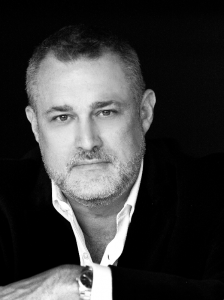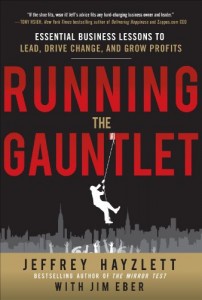 I’ve known Jeff Hayzlett for many years because of our association in the National Speakers Association and Sales and Marketing Executives International. A former Fortune 100 Chief Marketing Officer and global business celebrity, you’ve probably seen him on programs like Fox Business News, MSNBC’s Your Business and NBC’s Celebrity Apprentice with Donald Trump. Today he uses his creativity and extraordinary entrepreneurial skills to launch ventures blending his leadership perspectives, insights into professional development, mass marketing prowess and affinity for social media. The author of The Mirror Test, his latest book is Running the Gauntlet: Essential Business Lessons to Lead, Drive Change and Grow Profits.
I’ve known Jeff Hayzlett for many years because of our association in the National Speakers Association and Sales and Marketing Executives International. A former Fortune 100 Chief Marketing Officer and global business celebrity, you’ve probably seen him on programs like Fox Business News, MSNBC’s Your Business and NBC’s Celebrity Apprentice with Donald Trump. Today he uses his creativity and extraordinary entrepreneurial skills to launch ventures blending his leadership perspectives, insights into professional development, mass marketing prowess and affinity for social media. The author of The Mirror Test, his latest book is Running the Gauntlet: Essential Business Lessons to Lead, Drive Change and Grow Profits.
I asked him to share his insights on being a change agent from his new book in this guest blog:
 The gauntlet of change is cruel and change agents are exposed to all of its dastardly personnel: naysayers, obstructionists, backstabbers, and opportunists who use the messiness of change to stand in the way or shoot down new ideas. People at Kodak (read: naysayers, obstructionists, backstabbers, opportunists) liked to gossip about how I changed everything at Kodak — including, well, people.
The gauntlet of change is cruel and change agents are exposed to all of its dastardly personnel: naysayers, obstructionists, backstabbers, and opportunists who use the messiness of change to stand in the way or shoot down new ideas. People at Kodak (read: naysayers, obstructionists, backstabbers, opportunists) liked to gossip about how I changed everything at Kodak — including, well, people.
Change agents know gossip is part of the gauntlet they must run, and Kodak was no exception. Firings that were part of layoffs planned long before I became CMO? My fault. Obsolete divisions axed as part of the digital reinvention that started before I was on board? My fault. And “they” certainly noted that my new teams in marketing proved I was changing everything. Only this time, they were right. But just like the story about the badges, perception was not reality. You know how many new people I brought in at Kodak? One. I absolutely got rid of the wrong people and kept the winners. But then I looked at where the holes were skill-wise started to fill those holes by looking at the existing talent companywide, matching their skills to the work required, and recruiting and hiring internally first. I knew many people could, with the right leadership and direction, help lead the change we wanted and were hungry for the chance! They just weren’t empowered to lead or in the right positions to do so. Change agents must grant these people permission and cheer them on; remember: it takes a lot of strength to run this gauntlet.
In other words, get people in the right seats on the “bus,” adapting the lesson so many change agents learned about driving change from Jim Collins’ still-outstanding Good to Great. Leaders are able to do this because they are seam operators — literally they operate across the seams of the company. We don’t get involved in day-to-day processes outside of setting the operating principles. We don’t need to know too many details; we’ve already been through a lot of this before and don’t need it explained again. I tell my teams all the time, “I don’t want to know or hear about how sausage is made unless someone died. I get it. It’s sausage. Tell me what I need to know to get things moving.”
What I want to find out is what is breaking down between the seams of my company, between people and groups and from process to process. That’s what you listen to and why listening is probably the best skill a change agent can have — they listen throughout the organization and hear snippets from everyone and everywhere. That’s how they find out what they don’t know.
Change agents identify problems and then find ways to fix them or bring in people who can. This takes perseverance in any sized company, even small ones, where the same excuses always pop up. “That’s not my job…. That person or group does not report to me so I have no authority…. That’s not they way we do it…. That’s not within my budget….”
Change agents don’t care about excuses or worry about offending the “authorities” when attacked. They can’t. Like my approach with change at Kodak, they must act and go until someone tells you differently and then deal with that obstacle. Here’s why: The worst thing that happens is not that you make a mistake or piss someone off. Mistakes are inevitable and it’s our job to cause tension, which will occasionally piss people off. No, the worst thing is that you see something and don’t bring it up — you become seduced by the process and become part of the problem by failing to change it.
Change agents are already facing a herd mentality. Easier to blend and go with the flow than stand up and say wait a second. Most animals survive by blending with the herd. Who wants to be the white buffalo? That’s the one the wolf targets.
Change agents are white buffaloes.
This is especially true internally. Making things happen requires change agents to live in those seams of the company, work across its silos, and stick our noses into everything. We cause tension as much as we cheer people on. We push as much as we praise. We are going to get more than our share of abuse from c-suite executives, managers, legal, HR as we are those twentysomething employees with attitudes as big as busses and senses of entitlement to match who think — no, they know — they can do it better than you and then quits. Or how about that person who tells everyone he heard how “they” said you were awful to work for? And that person who….
Sometimes you think you can fix the problem, sometimes you just see how hard the change is going to be, and sometimes you are just exhausted. Leaders cannot back down and must remember this lesson from the trail: “If you’re ridin’ ahead of the herd, take a look back every now and then to make sure it’s still with ya.” If you lose touch with the herd, things can turn bad fast, but if you are too close to the herd, you’re eating dust. Whether you are leading thousands or just one, you need to find the right distance between the changes you seek with your company (employees, vendors, customers) and far enough ahead so you can actually lead them and not get caught up in how the sausage is made.








How can you tell the difference between a ‘white buffalo’ change agent and a sycophantic svengali?